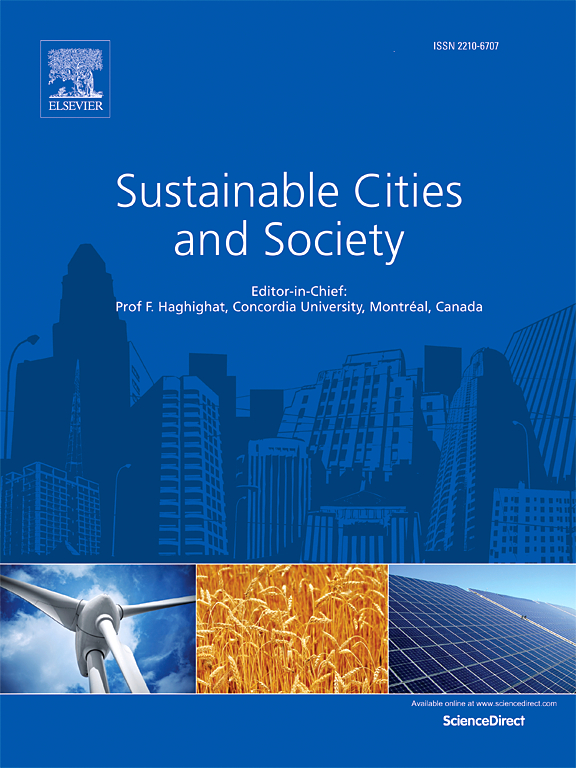Implementing blue-green infrastructures in cities – A methodological approach considering space constraints and microclimatic benefits
IF 10.5
1区 工程技术
Q1 CONSTRUCTION & BUILDING TECHNOLOGY
引用次数: 0
Abstract
In the context of globally rising temperatures, the imperative for climate change adaptation measures in cities is becoming increasingly apparent. Blue-green infrastructures (BGI) are recognised for their heat mitigating effects. However, urban settlements frequently face spatial constraints, that hinder their implementation. Consequently, this article introduces a methodological approach to systematically describe and assess urban street space to indicate possible space availability for BGI implementation in dense urban areas. We propose two scenarios, one context sensitive and one more disruptive, to free up and increase available space by altering current street usage while maintaining initial street functionality. Compositions of BGI were implemented in the scenarios according to space availability and their anticipated heat mitigation potency. Microclimatic computer simulation served to assess related temperature reducing capacities of the newly implemented BGI. The methodological approach was applied in a historic part of Vienna, Austria. Investigations clearly showed a positive correlation of the extent of BGI implementation and the reduction of physiological equivalent temperature (PET). Correlating space consumption and temperature reducing capacity of BGI implementations revealed differences in microclimatic and spatial efficiency. Most efficient reductions of PET were observed when 10–25 % of street surface was allocated for BGI. Our study suggests that allocating around 10 % of street surface for new BGI implementation can lead to considerable reductions of PET emphasising the potential for effective urban heat mitigation strategies. The results and the method developed provide new insights and possibilities for strategic urban planning, implementing heat mitigation strategies in dense urban areas while supporting existing concepts for the sustainable transformation of cities.
在城市中实施蓝绿色基础设施——考虑空间限制和微气候效益的方法学方法
在全球气温上升的背景下,城市采取气候变化适应措施的必要性日益明显。蓝绿基础设施(BGI)因其减热效果而得到认可。然而,城市住区往往面临空间限制,阻碍了其实施。因此,本文介绍了一种系统描述和评估城市街道空间的方法,以表明在人口密集的城市地区实施BGI的可能空间可用性。我们提出了两种方案,一种是环境敏感的,另一种更具破坏性,通过改变当前的街道使用方式来释放和增加可用空间,同时保持最初的街道功能。根据空间可用性和预期的减热效能,在不同场景中实施了华大基因的组合。小气候计算机模拟评价了新实施的华大基因的相关降温能力。方法方法在奥地利维也纳的一个历史地区得到应用。调查清楚地表明,BGI实施的程度与生理等效温度(PET)的降低呈正相关。将空间消耗与华大基因实施的降温能力相关联,揭示了小气候和空间效率的差异。当10 - 25%的街道表面被分配给华大基因时,PET的减少效率最高。我们的研究表明,分配大约10%的街道表面用于新的华大基因实施,可以显著减少PET,强调有效的城市热缓解策略的潜力。研究结果和开发的方法为战略性城市规划提供了新的见解和可能性,在人口密集的城市地区实施热缓解战略,同时支持城市可持续转型的现有概念。
本文章由计算机程序翻译,如有差异,请以英文原文为准。
求助全文
约1分钟内获得全文
求助全文
来源期刊

Sustainable Cities and Society
Social Sciences-Geography, Planning and Development
CiteScore
22.00
自引率
13.70%
发文量
810
审稿时长
27 days
期刊介绍:
Sustainable Cities and Society (SCS) is an international journal that focuses on fundamental and applied research to promote environmentally sustainable and socially resilient cities. The journal welcomes cross-cutting, multi-disciplinary research in various areas, including:
1. Smart cities and resilient environments;
2. Alternative/clean energy sources, energy distribution, distributed energy generation, and energy demand reduction/management;
3. Monitoring and improving air quality in built environment and cities (e.g., healthy built environment and air quality management);
4. Energy efficient, low/zero carbon, and green buildings/communities;
5. Climate change mitigation and adaptation in urban environments;
6. Green infrastructure and BMPs;
7. Environmental Footprint accounting and management;
8. Urban agriculture and forestry;
9. ICT, smart grid and intelligent infrastructure;
10. Urban design/planning, regulations, legislation, certification, economics, and policy;
11. Social aspects, impacts and resiliency of cities;
12. Behavior monitoring, analysis and change within urban communities;
13. Health monitoring and improvement;
14. Nexus issues related to sustainable cities and societies;
15. Smart city governance;
16. Decision Support Systems for trade-off and uncertainty analysis for improved management of cities and society;
17. Big data, machine learning, and artificial intelligence applications and case studies;
18. Critical infrastructure protection, including security, privacy, forensics, and reliability issues of cyber-physical systems.
19. Water footprint reduction and urban water distribution, harvesting, treatment, reuse and management;
20. Waste reduction and recycling;
21. Wastewater collection, treatment and recycling;
22. Smart, clean and healthy transportation systems and infrastructure;
 求助内容:
求助内容: 应助结果提醒方式:
应助结果提醒方式:


